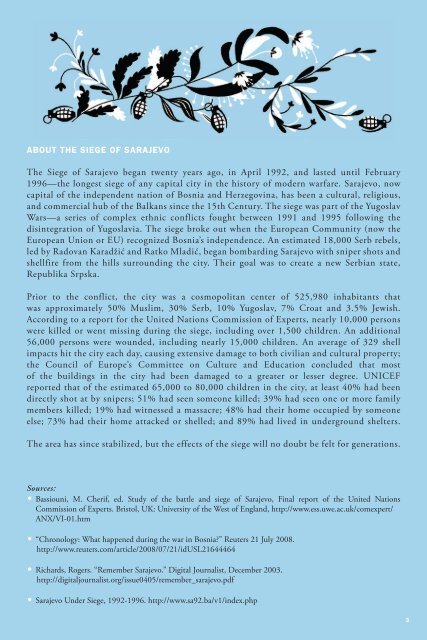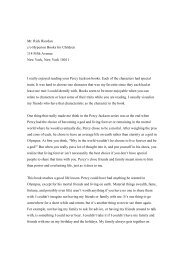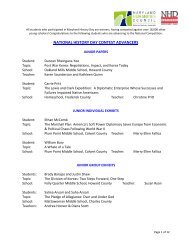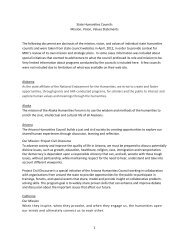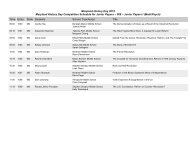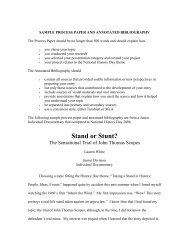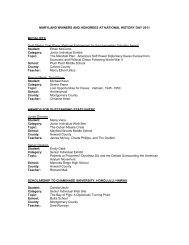Teacher's Guide for Grades 9-12 - Maryland Humanities Council
Teacher's Guide for Grades 9-12 - Maryland Humanities Council
Teacher's Guide for Grades 9-12 - Maryland Humanities Council
You also want an ePaper? Increase the reach of your titles
YUMPU automatically turns print PDFs into web optimized ePapers that Google loves.
ABOUT THE SIEGE OF SARAJEVO<br />
The Siege of Sarajevo began twenty years ago, in April 1992, and lasted until February<br />
1996—the longest siege of any capital city in the history of modern warfare. Sarajevo, now<br />
capital of the independent nation of Bosnia and Herzegovina, has been a cultural, religious,<br />
and commercial hub of the Balkans since the 15th Century. The siege was part of the Yugoslav<br />
Wars—a series of complex ethnic conflicts fought between 1991 and 1995 following the<br />
disintegration of Yugoslavia. The siege broke out when the European Community (now the<br />
European Union or EU) recognized Bosnia’s independence. An estimated 18,000 Serb rebels,<br />
led by Radovan Karadžić and Ratko Mladić, began bombarding Sarajevo with sniper shots and<br />
shellfire from the hills surrounding the city. Their goal was to create a new Serbian state,<br />
Republika Srpska.<br />
Prior to the conflict, the city was a cosmopolitan center of 525,980 inhabitants that<br />
was approximately 50% Muslim, 30% Serb, 10% Yugoslav, 7% Croat and 3.5% Jewish.<br />
According to a report <strong>for</strong> the United Nations Commission of Experts, nearly 10,000 persons<br />
were killed or went missing during the siege, including over 1,500 children. An additional<br />
56,000 persons were wounded, including nearly 15,000 children. An average of 329 shell<br />
impacts hit the city each day, causing extensive damage to both civilian and cultural property;<br />
the <strong>Council</strong> of Europe’s Committee on Culture and Education concluded that most<br />
of the buildings in the city had been damaged to a greater or lesser degree. UNICEF<br />
reported that of the estimated 65,000 to 80,000 children in the city, at least 40% had been<br />
directly shot at by snipers; 51% had seen someone killed; 39% had seen one or more family<br />
members killed; 19% had witnessed a massacre; 48% had their home occupied by someone<br />
else; 73% had their home attacked or shelled; and 89% had lived in underground shelters.<br />
The area has since stabilized, but the effects of the siege will no doubt be felt <strong>for</strong> generations.<br />
Sources:<br />
• Bassiouni, M. Cherif, ed. Study of the battle and siege of Sarajevo, Final report of the United Nations<br />
Commission of Experts. Bristol, UK: University of the West of England, http://www.ess.uwe.ac.uk/comexpert/<br />
ANX/VI-01.htm<br />
• “Chronology: What happened during the war in Bosnia?” Reuters 21 July 2008.<br />
http://www.reuters.com/article/2008/07/21/idUSL21644464<br />
• Richards, Rogers. “Remember Sarajevo.” Digital Journalist, December 2003.<br />
http://digitaljournalist.org/issue0405/remember_sarajevo.pdf<br />
• Sarajevo Under Siege, 1992-1996. http://www.sa92.ba/v1/index.php<br />
3


